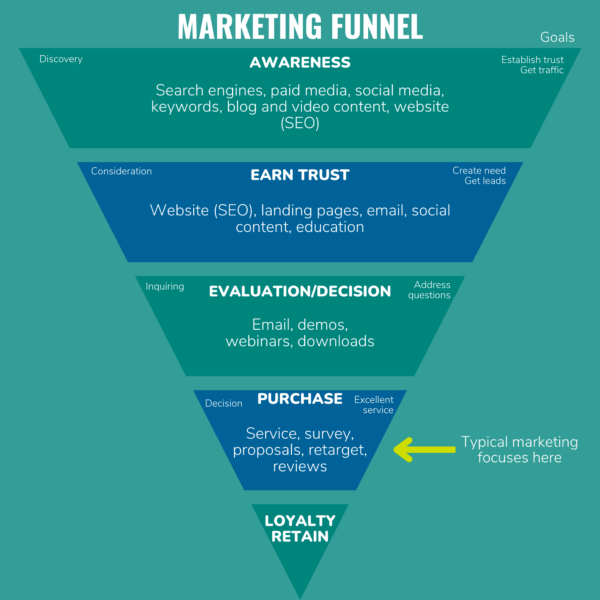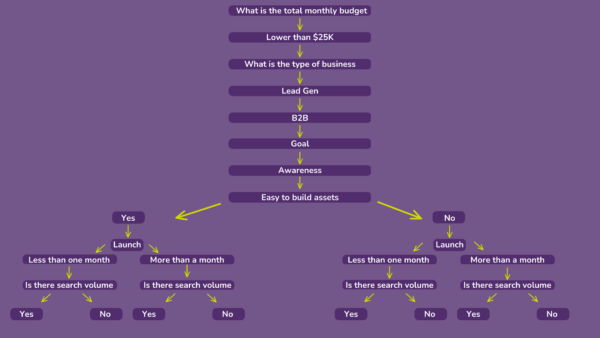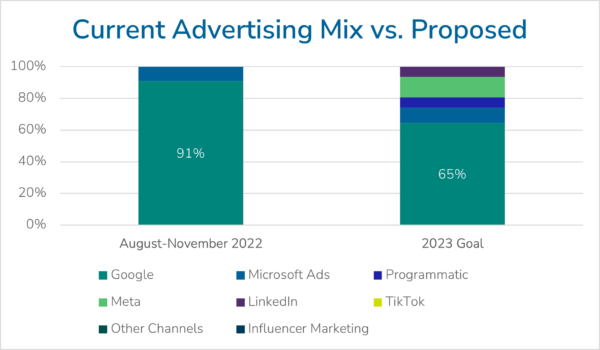As we’ve discussed in our previous articles in our B2B marketing series, diversification of channels and testing is key for the long term success and growth of every B2B business.
Unfortunately, we have found most businesses rely too heavily on one channel (Google in most cases), which leaves the business vulnerable to any change in channel or platform.
Additionally, B2B businesses tend to overfocus on last touch lead attribution. In the short term, this does help keep efforts very efficient, but over time it results in diminishing returns and limits growth opportunities.

None of the above is new information to experienced B2B marketers. But how do you diversify effectively? To start, the questions the marketing team needs to answer are:
- What channel or platform should be tested next?
- What % of spend should be dedicated to each channel/campaign?
- How should the tests be prioritized and what to run in each channel?
- How should tests be designed so that the team can understand the incrementality of the engagement?
Let’s discuss the first 2 questions.
What Channels or Platforms Should Be Tested?
At (un)Common Logic we’ve created a decision tree with over 375 scenarios to help our teams recommend media mix to our clients.
As with many situations in digital marketing, there is more than one right answer. Your right mix of channels should depend on many factors.
Budget
Some of them, like budget, are obvious. Smaller budgets dictate that fewer channels can run at the same time and require a higher focus on search.

However, there are other factors that will impact your media mix decision tree.
Search Volume
“You first must run on search” does not work for everything. There are occasions when B2B solves pain points where businesses cannot pinpoint the root cause or businesses are unaware the exact solution exists.
This is particularly the situation in B2B SaaS when a company develops a niche platform that is designed to understand the workflows of a specific type of business and provide efficiencies and consolidation of efforts that cut down frustrations. In these cases the majority of the niche market isn’t aware the exact solution exists and will not be able to search for it.
When this happens, the marketer has to find creative outlets to reach the audience at the right time.
Brand Recognition and Competition
While search volume around the pain point is important, having brand presence and recognition in a competitive environment is critical in entering the consideration stage. But building brand awareness cannot rely on search alone.
With B2B marketing, you must take the entire buying committee into consideration. Even when there is sufficient search volume, B2B purchases are almost never decided by one person who does the research. B2B marketers must therefore try to answer, how do we reach the non-searcher audience that will influence the decision?
Access to Marketing Assets
It’s easy to say that display and video efforts are critical to success in marketing; however the business must dedicate resources to continuously create and test assets that align with the brand voice.
Length of Buying Funnel
The longer the buying funnel, the more the business will need to create micro-conversion signals to immediately inform on the direct success of the activity as the buyer moves down the funnel.
Putting It All Together
Assuming you’ve taken all of these factors into consideration, the PPC channel mix and efforts we’d recommend a B2B business to run and test are:
- Conditions: Search volume exists, pain points are known, competitive market
- Google Search
- Microsoft Search
- Quora
- Conditions: Include buying committee consideration, reach non-searcher audiences
- Programmatic
- Meta
- YouTube
- Spotify podcasts
- TikTok
The number of channels/networks is heavily dependent on budget and goals, but even with low budgets, typically you should never have fewer than 3.
What Percentage of Spend Should Be Dedicated to Each Channel/Campaign?
Truth be told, the options are too great to list here. (un)Common Logic’s recommended percentage mix of spend and our channel recommendations are evolving over time as channels evolve their efficiency and targeting capabilities.
However, as a good rule of thumb, no channel should take up more than 75% of your total PPC budget.
Additionally, in 2023, your goal should be for Google to account for 65% of total PPC budget or less. This is not a knock on Google. At (un)Common Logic we simply find most businesses over-leverage the platform to their detriment, specifically in search, and miss great opportunities within other platforms. Moreover, it is actually to Google’s benefit that you diversify to other channels and networks and grow awareness.
For example, during a recent audit for a prospect, we found that Google represented 91% of their advertising mix for the second half of last year. We recommended that during this year, they test and shift advertising budget to other channels:

Your other budgetary considerations need to be able to answer the following questions affirmatively:
- Are we spending enough to make an impact for our business?
- Can we measure the impact of this channel on our business?
- Is the tool/platform/my team able to make optimization decisions based on the data?
If you answer no to one of these questions, your team needs to reevaluate the targeting (smaller audience, smaller location targeting, increase budget).
Once you’ve decided on your media mix, budget, and goals for each channel, you have to decide which options are best suited for your business within the channel. As you’re aware digital marketing can be a bottomless rabbit hole of possibilities.
In our next article in the series, we’ll explore the different options within search, social, and programmatic and propose ideas for testing plans.
- Options with programmatic
- Options with Social
- Options with Search
Contact us to talk about your B2B marketing efforts and how our (un)Common approach can help!
As we’ve discussed in our previous articles in our B2B marketing series, diversification of channels and testing is key for the long term success and growth of every B2B business.
Unfortunately, we have found most businesses rely too heavily on one channel (Google in most cases), which leaves the business vulnerable to any change in channel or platform.
Additionally, B2B businesses tend to overfocus on last touch lead attribution. In the short term, this does help keep efforts very efficient, but over time it results in diminishing returns and limits growth opportunities.

None of the above is new information to experienced B2B marketers. But how do you diversify effectively? To start, the questions the marketing team needs to answer are:
- What channel or platform should be tested next?
- What % of spend should be dedicated to each channel/campaign?
- How should the tests be prioritized and what to run in each channel?
- How should tests be designed so that the team can understand the incrementality of the engagement?
Let’s discuss the first 2 questions.
What Channels or Platforms Should Be Tested?
At (un)Common Logic we’ve created a decision tree with over 375 scenarios to help our teams recommend media mix to our clients.
As with many situations in digital marketing, there is more than one right answer. Your right mix of channels should depend on many factors.
Budget
Some of them, like budget, are obvious. Smaller budgets dictate that fewer channels can run at the same time and require a higher focus on search.

However, there are other factors that will impact your media mix decision tree.
Search Volume
“You first must run on search” does not work for everything. There are occasions when B2B solves pain points where businesses cannot pinpoint the root cause or businesses are unaware the exact solution exists.
This is particularly the situation in B2B SaaS when a company develops a niche platform that is designed to understand the workflows of a specific type of business and provide efficiencies and consolidation of efforts that cut down frustrations. In these cases the majority of the niche market isn’t aware the exact solution exists and will not be able to search for it.
When this happens, the marketer has to find creative outlets to reach the audience at the right time.
Brand Recognition and Competition
While search volume around the pain point is important, having brand presence and recognition in a competitive environment is critical in entering the consideration stage. But building brand awareness cannot rely on search alone.
With B2B marketing, you must take the entire buying committee into consideration. Even when there is sufficient search volume, B2B purchases are almost never decided by one person who does the research. B2B marketers must therefore try to answer, how do we reach the non-searcher audience that will influence the decision?
Access to Marketing Assets
It’s easy to say that display and video efforts are critical to success in marketing; however the business must dedicate resources to continuously create and test assets that align with the brand voice.
Length of Buying Funnel
The longer the buying funnel, the more the business will need to create micro-conversion signals to immediately inform on the direct success of the activity as the buyer moves down the funnel.
Putting It All Together
Assuming you’ve taken all of these factors into consideration, the PPC channel mix and efforts we’d recommend a B2B business to run and test are:
- Conditions: Search volume exists, pain points are known, competitive market
- Google Search
- Microsoft Search
- Quora
- Conditions: Include buying committee consideration, reach non-searcher audiences
- Programmatic
- Meta
- YouTube
- Spotify podcasts
- TikTok
The number of channels/networks is heavily dependent on budget and goals, but even with low budgets, typically you should never have fewer than 3.
What Percentage of Spend Should Be Dedicated to Each Channel/Campaign?
Truth be told, the options are too great to list here. (un)Common Logic’s recommended percentage mix of spend and our channel recommendations are evolving over time as channels evolve their efficiency and targeting capabilities.
However, as a good rule of thumb, no channel should take up more than 75% of your total PPC budget.
Additionally, in 2023, your goal should be for Google to account for 65% of total PPC budget or less. This is not a knock on Google. At (un)Common Logic we simply find most businesses over-leverage the platform to their detriment, specifically in search, and miss great opportunities within other platforms. Moreover, it is actually to Google’s benefit that you diversify to other channels and networks and grow awareness.
For example, during a recent audit for a prospect, we found that Google represented 91% of their advertising mix for the second half of last year. We recommended that during this year, they test and shift advertising budget to other channels:

Your other budgetary considerations need to be able to answer the following questions affirmatively:
- Are we spending enough to make an impact for our business?
- Can we measure the impact of this channel on our business?
- Is the tool/platform/my team able to make optimization decisions based on the data?
If you answer no to one of these questions, your team needs to reevaluate the targeting (smaller audience, smaller location targeting, increase budget).
Once you’ve decided on your media mix, budget, and goals for each channel, you have to decide which options are best suited for your business within the channel. As you’re aware digital marketing can be a bottomless rabbit hole of possibilities.
In our next article in the series, we’ll explore the different options within search, social, and programmatic and propose ideas for testing plans.
- Options with programmatic
- Options with Social
- Options with Search
Contact us to talk about your B2B marketing efforts and how our (un)Common approach can help!

